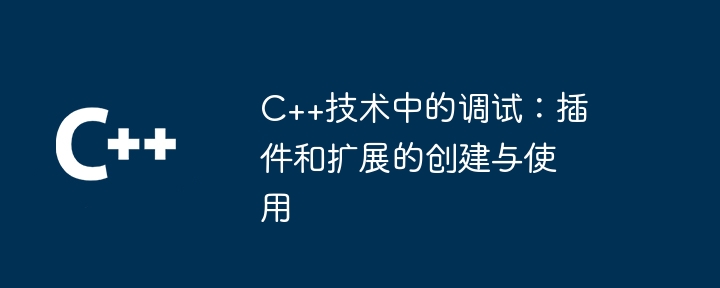
Plug-ins and extensions in C Debugging enhance debugging capabilities. Plug-ins are created using Visual Studio (for example: custom exception message display), while extensions are usually created in C#/Python and extend the functionality of the debugger itself (for example: calling Python functions in Visual Studio). Creating a plug-in involves defining an exported class, while an extension focuses on extending debugger functionality. When integrating, copy the plug-in DLL to the Visual Studio installation directory and enable the extension via Tools > Options > Debugging > Python Windows. Plug-ins and extensions improve the insight and reliability of your C debugging sessions.

Debugging in C Technology: Creating and Using Plugins and Extensions
In C development, debugging is essential part. It enables developers to identify and resolve potential problems in programs, thereby ensuring the correctness and robustness of the code. Plugins and extensions are valuable tools in the C debugging toolbox and can enhance the capabilities of your debugging session.
Creating a plug-in
The process of creating a C plug-in using Visual Studio involves the following steps:
// 定义Visual Studio插件中要导出的类
class MyPlugin : public IDkmCustomModule
{
public:
// 实现IDkmCustomModule::ExecuteCommand接口
HRESULT STDMETHODCALLTYPE ExecuteCommand(
IDkmCustomModuleExecutionContext* context,
IDkmModuleEnum* selectedModulesEnumerator,
const BSTR* pCommandName) override;
// 其他方法...
};Creating an extension
C extensions are more focused on extending the functionality of the debugger itself. Typically created using C# or Python, it can be integrated with the Visual Studio debugger. Here is an example of a Python extension:
import clr
# 导入Python服务模块
python_services = clr.LoadAssemblyByName("Microsoft.VisualStudio.Debugger.Interop.Python")
# 创建Python调试器服务类
debugger_services = python_services.CreatePythonServices()Using Plugins and Extensions
After you create plugins and extensions, it is important to integrate them into your Visual Studio debugging session:
Using plugins:
<visual studio installation directory>\Common7\IDE\Extensions</visual> directory. Use the extension:
Practical case
Consider the following practical case:
Conclusion
Plugins and extensions are powerful tools for enhancing your C debugging session. By creating and using these tools, developers gain a deeper understanding of program behavior, thereby improving the quality and reliability of their code.
The above is the detailed content of Debugging in C++ technology: Creation and use of plug-ins and extensions. For more information, please follow other related articles on the PHP Chinese website!




